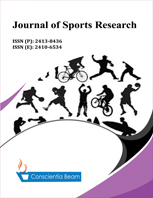The Relationship among Body Composition, Exercise Participation, and Perception towards a Lifetime Fitness Class in College Students
DOI:
https://doi.org/10.18488/journal.90.2021.82.49.63Abstract
The current study analyzed the relationship between body composition and exercise participation, along with perception toward lifetime fitness (LF) classes in college students. Thirty-eight college students (20 males and 18 females) in a regional university completed a survey pertaining an LF class and exercise participation. Additionally, height, weight, waist-to-hip ratio, and body composition [fat free mass (FFM), fat mass (FM), and body fat percentage (BF%)] were assessed. Most males (65%) and females (77%) reported personal wellbeing as their main motivation to exercise (p = 0.021) outside of their LF class, rather than it being driven by a personal achievement motivation (35% males and 23% females). Males who exercise less than twice a week were associated with having lower FFM (p = 0.041), whereas females who exercise less than twice a week were associated with lower body mass index (p = 0.004), FFM (p = 0.027), and FM (p = 0.001). Although personal wellbeing was the main motivation to exercise for both male and female students, each sex has shown unique trends in its desires to participate in an LF class. Therefore, future LF classes should consider adopting curriculums that are able to uphold personal wellbeing motivation and account for unique needs and goals males and females may have in order to promote LF class engagement.

